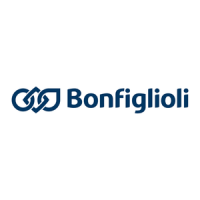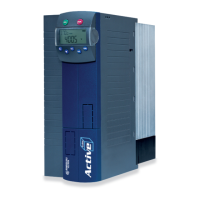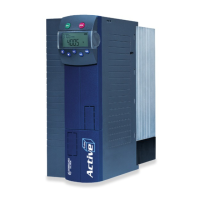
Do you have a question about the BONFIGLIOLI ACTIVE Cube ACU 401-18 and is the answer not in the manual?
| Model | ACU 401-18 |
|---|---|
| Category | Inverter |
| Rated Power | 18.5 kW |
| Output Current | 38 A |
| Protection Class | IP20 |
| Protection Degree | IP20 |
| Input Voltage | 380-480 V |
| Frequency | 0-599 Hz |
| Control Method | V/f control, Sensorless vector control, Closed-loop vector control |
Specifies the intended design and use of the frequency inverters in industrial plants and machines.
Provides critical safety instructions for operating the frequency inverter, including avoiding hazards and proper use.
Explains the STO function, its safety provisions, installation requirements, and proper commissioning.
Shows standard installation dimensions for ACU 201 (up to 3.0 kW) and ACU 401 (up to 4.0 kW).
Shows standard installation dimensions for ACU 201 (4.0-9.2 kW) and ACU 401 (5.5-15.0 kW).
Shows standard installation dimensions for ACU 401 (18.5 to 30.0 kW) frequency inverters.
Shows standard installation dimensions for ACU 401 (37.0 to 65.0 kW) frequency inverters.
Shows standard installation dimensions for ACU 401 (75.0 to 132.0 kW) frequency inverters.
Provides measures to minimize electromagnetic interference, including mounting, bonding, and cable routing.
Details conductor cross-section dimensioning and typical cross-sections for mains, PE, and motor connections.
Provides instructions for connecting the mains power supply, including safety precautions and cable selection.
Details safe motor connection, including shielded cables, ground potential, and line separation.
Explains the connection and dimensioning of a brake resistor, including safety warnings for high temperatures.
Details the copy function for uploading and downloading parameter values between the control unit and frequency inverter.
Provides safety instructions and checks before switching on the mains voltage.
Guides through the setup process, including parameter identification and configuration selection.
Explains how to check the drive's direction of rotation against the reference value and exchange phases if necessary.
Explains how Configuration 30 determines control input/output assignments and software functions.
Instructs to set rated motor parameters from the rating plate for control functions and methods.
Defines parameterization for starting behavior, including flux formation and IxR compensation for sensorless control.
Details various stopping behaviors (free stopping, stop+hold, DC brakes, emergency stop) defined by Operation mode 630.
Explains the search run function for synchronizing to a rotating drive and determining flux direction.
Covers positioning functions: Reference positioning and Axle positioning, activated via Operation mode 458.
Defines warning limits for short-term and long-term Ixt overload, related to switching frequency and ambient conditions.
Covers warning limits for heat sink and inside temperatures, and their relation to switch-off limits.
Describes motor temperature monitoring via control terminals, Operation mode 570, and temperature limits.
Defines Minimum frequency 418 and Maximum frequency 419 for output frequency and speed setting range.
Explains how frequency ramps (acceleration/deceleration) determine change speed, including S-curve and emergency stop ramps.
Explains motor speed control via motor potentiometer function using digital signals or control unit keys.
Details configuration of MFI1 as voltage, current, or digital input, and its link to software functions.
Explains current limits for avoiding inadmissible load and preventing fault switch-off, extending the current controller.
Details functions for monitoring DC link voltage and power failure regulation, set via Operation Mode 670.
Describes the PID controller for process control (pressure, volume flow, speed) using reference and actual values.
Explains field-orientated control based on cascade control and machine model, including Current Controller and Torque Controller.
Details selecting the actual speed source and operation modes for the speed controller, including parameterization of limits.
Explains the function of the brake chopper transistor and external brake resistor connection.
Covers motor protection against temperature rise using temperature sensors or I2t monitoring.
Provides a list of fault messages, including last error, error count, and self-acknowledged errors.
Provides a structured list of all parameters organized by menu branches, with setting ranges and chapter references.











